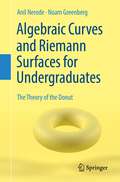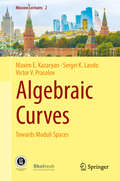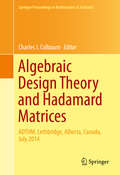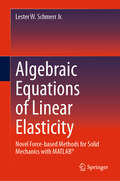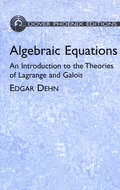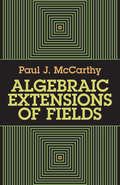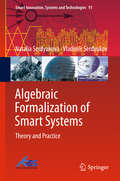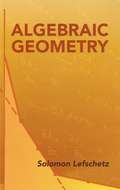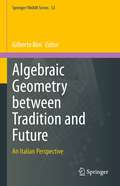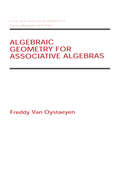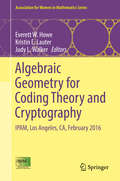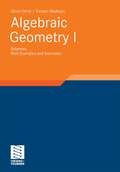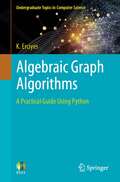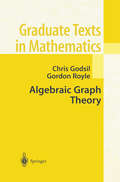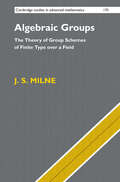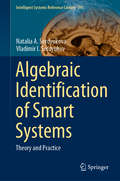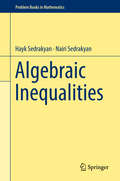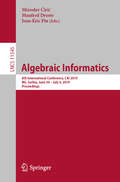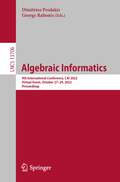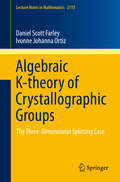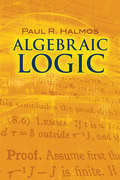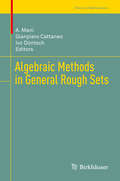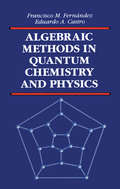- Table View
- List View
Algebraic Curves and Riemann Surfaces for Undergraduates: The Theory of the Donut
by Noam Greenberg Anil NerodeThe theory relating algebraic curves and Riemann surfaces exhibits the unity of mathematics: topology, complex analysis, algebra and geometry all interact in a deep way. This textbook offers an elementary introduction to this beautiful theory for an undergraduate audience. At the heart of the subject is the theory of elliptic functions and elliptic curves. A complex torus (or “donut”) is both an abelian group and a Riemann surface. It is obtained by identifying points on the complex plane. At the same time, it can be viewed as a complex algebraic curve, with addition of points given by a geometric “chord-and-tangent” method. This book carefully develops all of the tools necessary to make sense of this isomorphism. The exposition is kept as elementary as possible and frequently draws on familiar notions in calculus and algebra to motivate new concepts. Based on a capstone course given to senior undergraduates, this book is intended as a textbook for courses at this level and includes a large number of class-tested exercises. The prerequisites for using the book are familiarity with abstract algebra, calculus and analysis, as covered in standard undergraduate courses.
Algebraic Curves in Cryptography (Discrete Mathematics and Its Applications)
by San Ling Huaxiong Wang Chaoping XingThe reach of algebraic curves in cryptography goes far beyond elliptic curve or public key cryptography yet these other application areas have not been systematically covered in the literature. Addressing this gap, Algebraic Curves in Cryptography explores the rich uses of algebraic curves in a range of cryptographic applications, such as secret sh
Algebraic Curves: Towards Moduli Spaces (Moscow Lectures #2)
by Maxim E. Kazaryan Sergei K. Lando Victor V. PrasolovThis book offers a concise yet thorough introduction to the notion of moduli spaces of complex algebraic curves. Over the last few decades, this notion has become central not only in algebraic geometry, but in mathematical physics, including string theory, as well. The book begins by studying individual smooth algebraic curves, including the most beautiful ones, before addressing families of curves. Studying families of algebraic curves often proves to be more efficient than studying individual curves: these families and their total spaces can still be smooth, even if there are singular curves among their members. A major discovery of the 20th century, attributed to P. Deligne and D. Mumford, was that curves with only mild singularities form smooth compact moduli spaces. An unexpected byproduct of this discovery was the realization that the analysis of more complex curve singularities is not a necessary step in understanding the geometry of the moduli spaces. The book does not use the sophisticated machinery of modern algebraic geometry, and most classical objects related to curves – such as Jacobian, space of holomorphic differentials, the Riemann-Roch theorem, and Weierstrass points – are treated at a basic level that does not require a profound command of algebraic geometry, but which is sufficient for extending them to vector bundles and other geometric objects associated to moduli spaces. Nevertheless, it offers clear information on the construction of the moduli spaces, and provides readers with tools for practical operations with this notion. Based on several lecture courses given by the authors at the Independent University of Moscow and Higher School of Economics, the book also includes a wealth of problems, making it suitable not only for individual research, but also as a textbook for undergraduate and graduate coursework
Algebraic Design Theory and Hadamard Matrices: ADTHM, Lethbridge, Alberta, Canada, July 2014 (Springer Proceedings in Mathematics & Statistics #133)
by Charles J. ColbournThis volume develops the depth and breadth of the mathematics underlying the construction and analysis of Hadamard matrices, and their use in the construction of combinatorial designs. At the same time, it pursues current research in their numerous applications in security and cryptography, quantum information, and communications. Bridges among diverse mathematical threads and extensive applications make this an invaluable source for understanding both the current state of the art and future directions. The existence of Hadamard matrices remains one of the most challenging open questions in combinatorics. Substantial progress on their existence has resulted from advances in algebraic design theory using deep connections with linear algebra, abstract algebra, finite geometry, number theory, and combinatorics. Hadamard matrices arise in a very diverse set of applications. Starting with applications in experimental design theory and the theory of error-correcting codes, they have found unexpected and important applications in cryptography, quantum information theory, communications, and networking.
Algebraic Equations of Linear Elasticity: Novel Force-based Methods for Solid Mechanics with MATLAB®
by Lester W. Schmerr Jr.This book describes a second-generation force-based method emerging from a general formulation where the partial differential equations of elasticity are replaced by equivalent algebraic equations. These algebraic equations of linear elasticity can be used to solve statically indeterminate problems in reduced forms that define either the new second-generation force-based approach or a new displacement-based approach. The new force-based method can serve as the basis for teaching students at many technical levels how to solve equilibrium problems directly for the forces present. In elasticity courses, the derivation and use of the algebraic equations of linear elasticity can show how the difficulties of dealing with partial differential equations may be avoided by transforming those equations into algebraic equations with work-energy concepts. In a finite element course, a force-based finite element method can be described along with the traditional displacement-based approach to demonstrate how the two methods provide alternative ways for solving complex structural problems. Serving as a resource for including second-generation force-based methods in solid mechanics courses of an engineering curriculum, and as a robust learning resource, the book is ideal for instructors and for students, practicing engineers, and researchers.
Algebraic Equations: An Introduction to the Theories of Lagrange and Galois
by Edgar DehnMeticulous and complete, this presentation of Galois' theory of algebraic equations is geared toward upper-level undergraduate and graduate students. The theories of both Lagrange and Galois are developed in logical rather than historical form. And they are given a more thorough exposition than is customary. For this reason, and also because the author concentrates on concrete applications of algebraic theory, Algebraic Equations is an excellent supplementary text, offering students a concrete introduction to the abstract principles of Galois theory. Of further value are the many numerical examples throughout the book, which appear with complete solutions.A third of the text focuses on the basic ideas of algebraic theory, giving detailed explanations of integral functions, permutations, and groups. in addition to a very clear exposition of the symmetric group and its functions. A study of the theory of Lagrange follows. Using Lagrange's solvent as a basis for the solution of the general quadratic, cubic, and biquadratic equations. After a discussion of various groups (including isomorphic, transitive, and Abelian groups), a detailed study of Galois theory covers the properties of the Galoisian function, resolvent. and group, the general equation, reductions of the group, natural irrationality. and other features. The book concludes with the application of Galoisian theory to the solution of such special equations as Abelian, cyclic, metacyclic, and quintic equations.
Algebraic Extensions of Fields
by Paul J. Mccarthy"...clear, unsophisticated and direct..." -- MathThis textbook is intended to prepare graduate students for the further study of fields, especially algebraic number theory and class field theory. It presumes some familiarity with topology and a solid background in abstract algebra. Chapter 1 contains the basic results concerning algebraic extensions. In addition to separable and inseparable extensions and normal extensions, there are sections on finite fields, algebraically closed fields, primitive elements, and norms and traces. Chapter 2 is devoted to Galois theory. Besides the fundamental theorum of Galois theory and some examples, it contains discussions of cyclic extensions, Abelian extensions (Kummer theory), and the solutions of polynomial equations by radicals. Chapter 2 concludes with three sections devoted to the study of infinite algebraic extensions. The study of valuation theory, including a thorough discussion of prolongations of valuations, begins with Chapter 3. Chapter 4 is concerned with extensions of valuated field, and in particular, with extensions of complete valuated fields. Chapter 5 contains a proof of the unique factorization theorum for ideals of the ring of integers of an algebraic number field. The treatment is valuation-theoretic throughout. The chapter also contains a discussion of extensions of such fields. A special feature of this book is its more than 200 exercises - many of which contain new ideas and powerful applications - enabling students to see theoretical results studied in the text amplified by integration with these concrete exercises.
Algebraic Formalization of Smart Systems: Theory And Practice (Smart Innovation, Systems And Technologies #91)
by Natalia Serdyukova Vladimir Serdyukov<P>This book reveals the general laws of the theory of smart systems with the help of a very powerful and expressive language of algebraic formalization. It also shows how this language can be used to substantiate practical results in the field of smart systems, which previously had only an empirical justification. Further, it proposes a translation of the theory of smart systems from verbal language to a much more expressive language of algebraic formalization, allowing the laws of the theory of smart systems to be seen in a different light. <P>In 1937 L. Bertalanffy proposed the concept of an algebraic system and the development of a mathematical apparatus for describing systems. In the 1970s, A.I. Mal'tsev developed a theory of algebraic systems connecting algebra and logic for studying algebraic and logical objects. In the 1990s, the concept of purities by predicates was introduced by one of the authors, and the book includes some of its applications. The concept, which is based on the theory of algebraic systems, allows clarification of the connections between quantitative and qualitative analysis of a system. <P>The book is intended for readers who use elements of artificial intelligence in their work
Algebraic Geometry
by Solomon LefschetzThis text for advanced undergraduate students is both an introduction to algebraic geometry and a bridge between its two parts — the analytical-topological and the algebraic. Because of its extensive use of formal power series (power series without convergency), the treatment will appeal to readers conversant with analysis but less familiar with the formidable techniques of modern algebra. The book opens with an overview of the results required from algebra and proceeds to the fundamental concepts of the general theory of algebraic varieties: general point, dimension, function field, rational transformations, and correspondences. A concentrated chapter on formal power series with applications to algebraic varieties follows. An extensive survey of algebraic curves includes places, linear series, abelian differentials, and algebraic correspondences. The text concludes with an examination of systems of curves on a surface.
Algebraic Geometry and Statistical Learning Theory
by Sumio WatanabeThe Cambridge Monographs on Applied and computational Mathematics reflect the crucial role of mathematical and computational techniques in contemporary science. The series includes titles in the Library of Computational Mathematics, published under the auspices of the Foundations of Computational Mathematics organisation. Sure to be influential, this book lays the foundations for the use of algebraic geometry in statistical learning theory. Many widely used statistical models and learning machines applied to information science have a parameter space that is singular: mixture models, neural networks, HMMS, Bayesian networks, and stochastic context-free grammars are major examples. Algebraic geometry and singularity theory provide the necessary tools for studying such non-smooth models. Four main formulas are established: (1) the log likelihood function can be given a common standard form using resolution of singularities, even applied to more complex models; (2) the asymptotic behavior of the marginal likelihood or ôthe evidenceô is derived based on zeta function theory; (3) new methods are derived to estimate the generalization errors in Bayes and Gibbs estimations from training errors; (4) the generalization errors of ; maximum likelihood and a posteriori methods are clarified by empirical process theory on algebraic varieties. Book jacket.
Algebraic Geometry between Tradition and Future: An Italian Perspective (Springer INdAM Series #53)
by Gilberto BiniAn incredible season for algebraic geometry flourished in Italy between 1860, when Luigi Cremona was assigned the chair of Geometria Superiore in Bologna, and 1959, when Francesco Severi published the last volume of the treatise on algebraic systems over a surface and an algebraic variety. This century-long season has had a prominent influence on the evolution of complex algebraic geometry - both at the national and international levels - and still inspires modern research in the area. "Algebraic geometry in Italy between tradition and future" is a collection of contributions aiming at presenting some of these powerful ideas and their connection to contemporary and, if possible, future developments, such as Cremonian transformations, birational classification of high-dimensional varieties starting from Gino Fano, the life and works of Guido Castelnuovo, Francesco Severi's mathematical library, etc. The presentation is enriched by the viewpoint of various researchers of the history of mathematics, who describe the cultural milieu and tell about the bios of some of the most famous mathematicians of those times.
Algebraic Geometry for Associative Algebras (Chapman & Hall/CRC Pure and Applied Mathematics)
by Freddy Van OystaeyenThis work focuses on the association of methods from topology, category and sheaf theory, algebraic geometry, noncommutative and homological algebras, quantum groups and spaces, rings of differential operation, Cech and sheaf cohomology theories, and dimension theories to create a blend of noncommutative algebraic geometry. It offers a scheme theor
Algebraic Geometry for Coding Theory and Cryptography: IPAM, Los Angeles, CA, February 2016 (Association for Women in Mathematics Series #9)
by Everett W. Howe Kristin E. Lauter Judy L. WalkerCovering topics in algebraic geometry, coding theory, and cryptography, this volume presents interdisciplinary group research completed for the February 2016 conference at the Institute for Pure and Applied Mathematics (IPAM) in cooperation with the Association for Women in Mathematics (AWM). The conference gathered research communities across disciplines to share ideas and problems in their fields and formed small research groups made up of graduate students, postdoctoral researchers, junior faculty, and group leaders who designed and led the projects. Peer reviewed and revised, each of this volume's five papers achieves the conference's goal of using algebraic geometry to address a problem in either coding theory or cryptography. Proposed variants of the McEliece cryptosystem based on different constructions of codes, constructions of locally recoverable codes from algebraic curves and surfaces, and algebraic approaches to the multicast network coding problem are only some of the topics covered in this volume. Researchers and graduate-level students interested in the interactions between algebraic geometry and both coding theory and cryptography will find this volume valuable.
Algebraic Geometry: Part I: Schemes. With Examples and Exercises (Advanced Lectures in Mathematics)
by Ulrich Görtz Torsten WedhornThis book introduces the reader to modern algebraic geometry. It presents Grothendieck's technically demanding language of schemes that is the basis of the most important developments in the last fifty years within this area. A systematic treatment and motivation of the theory is emphasized, using concrete examples to illustrate its usefulness. Several examples from the realm of Hilbert modular surfaces and of determinantal varieties are used methodically to discuss the covered techniques. Thus the reader experiences that the further development of the theory yields an ever better understanding of these fascinating objects. The text is complemented by many exercises that serve to check the comprehension of the text, treat further examples, or give an outlook on further results. The volume at hand is an introduction to schemes. To get startet, it requires only basic knowledge in abstract algebra and topology. Essential facts from commutative algebra are assembled in an appendix. It will be complemented by a second volume on the cohomology of schemes.
Algebraic Graph Algorithms: A Practical Guide Using Python (Undergraduate Topics in Computer Science)
by K. ErciyesThis textbook discusses the design and implementation of basic algebraic graph algorithms, and algebraic graph algorithms for complex networks, employing matroids whenever possible. The text describes the design of a simple parallel matrix algorithm kernel that can be used for parallel processing of algebraic graph algorithms. Example code is presented in pseudocode, together with case studies in Python and MPI. The text assumes readers have a background in graph theory and/or graph algorithms.
Algebraic Graph Theory (Graduate Texts in Mathematics #207)
by Chris Godsil Gordon RoyleThis book presents and illustrates the main tools and ideas of algebraic graph theory, with a primary emphasis on current rather than classical topics. It is designed to offer self-contained treatment of the topic, with strong emphasis on concrete examples.
Algebraic Groups: The Theory of Group Schemes of Finite Type over a Field (Cambridge Studies in Advanced Mathematics #170)
by J. S. MilneAlgebraic groups play much the same role for algebraists as Lie groups play for analysts. This book is the first comprehensive introduction to the theory of algebraic group schemes over fields that includes the structure theory of semisimple algebraic groups, and is written in the language of modern algebraic geometry. The first eight chapters study general algebraic group schemes over a field and culminate in a proof of the Barsotti-Chevalley theorem, realizing every algebraic group as an extension of an abelian variety by an affine group. After a review of the Tannakian philosophy, the author provides short accounts of Lie algebras and finite group schemes. The later chapters treat reductive algebraic groups over arbitrary fields, including the Borel-Chevalley structure theory. Solvable algebraic groups are studied in detail. Prerequisites have also been kept to a minimum so that the book is accessible to non-specialists in algebraic geometry.
Algebraic Identification of Smart Systems: Theory аnd Practice (Intelligent Systems Reference Library #191)
by Natalia A. Serdyukova Vladimir I. SerdyukovThis book is a continuation of our recently published book “Algebraic formalization of smart systems. Theory and practice.” It incorporates a new concept of quasi-fractal algebraic systems, based on A.I. Maltsev’s theory of algebraic systems and the theory of fractals developed by Benoit Mandelbrot, to investigate smart systems in more detail. The main tool used in the book, quasi-fractal algebraic systems, helps us to see smart systems in more detail by adding new factors, which e.g. make it possible to describe the previously indivisible elements of the initial model of factors. The techniques presented include fixed-point theorem, theorems of group theory, theory of Boolean algebras, and Erdös-Renyi algorithms. Given its focus, the book is intended for anyone interested in smart system theory.
Algebraic Inequalities (Problem Books in Mathematics)
by Hayk Sedrakyan Nairi SedrakyanThis unique collection of new and classical problems provides full coverage of algebraic inequalities. Many of the exercises are presented with detailed author-prepared-solutions, developing creativity and an arsenal of new approaches for solving mathematical problems. Algebraic Inequalities can be considered a continuation of the book Geometric Inequalities: Methods of Proving by the authors. This book can serve teachers, high-school students, and mathematical competitors. It may also be used as supplemental reading, providing readers with new and classical methods for proving algebraic inequalities.
Algebraic Informatics: 8th International Conference, CAI 2019, Niš, Serbia, June 30–July 4, 2019, Proceedings (Lecture Notes in Computer Science #11545)
by Manfred Droste Miroslav Ćirić Jean-Éric PinThis book constitutes the refereed proceedings of the 8th International Conference on Algebraic Informatics, CAI 2019, held in Niš, Serbia, in June/July 2019. The 20 revised papers presented were carefully reviewed and selected from 35 submissions. The papers present research at the intersection of theoretical computer science, algebra, and related areas. They report original unpublished research and cover a broad range of topics from automata theory and logic, cryptography and coding theory, computer algebra, design theory, natural and quantum computation, and related areas.
Algebraic Informatics: 9th International Conference, CAI 2022, Virtual Event, October 27–29, 2022, Proceedings (Lecture Notes in Computer Science #13706)
by George Rahonis Dimitrios PoulakisThis book constitutes the proceedings of the 9th International Conference on Algebraic Informatics, CAI 2022, held as virtual event, in October 27–29, 2022.The 2 abstracts, 3 full papers of invited speakers, and 12 contributed papers presented in this volume were carefully reviewed and selected from 17 submissions. The papers contain original and unpublished research; the topics of them lie in automata theory, cryptography, coding theory, DNA computation, computer algebra, and theory of software architectures.
Algebraic K-theory of Crystallographic Groups: The Three-Dimensional Splitting Case (Lecture Notes in Mathematics #2113)
by Daniel Scott Farley Ivonne Johanna OrtizThe Farrell-Jones isomorphism conjecture in algebraic K-theory offers a description of the algebraic K-theory of a group using a generalized homology theory. In cases where the conjecture is known to be a theorem, it gives a powerful method for computing the lower algebraic K-theory of a group. This book contains a computation of the lower algebraic K-theory of the split three-dimensional crystallographic groups, a geometrically important class of three-dimensional crystallographic group, representing a third of the total number. The book leads the reader through all aspects of the calculation. The first chapters describe the split crystallographic groups and their classifying spaces. Later chapters assemble the techniques that are needed to apply the isomorphism theorem. The result is a useful starting point for researchers who are interested in the computational side of the Farrell-Jones isomorphism conjecture, and a contribution to the growing literature in the field.
Algebraic Logic (Dover Books on Mathematics #154)
by Paul R. HalmosBeginning with an introduction to the concepts of algebraic logic, this concise volume features ten articles by a prominent mathematician that originally appeared in journals from 1954 to 1959. Covering monadic and polyadic algebras, these articles are essentially self-contained and accessible to a general mathematical audience, requiring no specialized knowledge of algebra or logic.Part One addresses monadic algebras, with articles on general theory, representation, and freedom. Part Two explores polyadic algebras, progressing from general theory and terms to equality. Part Three offers three items on polyadic Boolean algebras, including a survey of predicates, terms, operations, and equality. The book concludes with an additional bibliography and index.
Algebraic Methods in General Rough Sets (Trends in Mathematics)
by A. Mani Gianpiero Cattaneo Ivo DüntschThis unique collection of research papers offers a comprehensive and up-to-date guide to algebraic approaches to rough sets and reasoning with vagueness. It bridges important gaps, outlines intriguing future research directions, and connects algebraic approaches to rough sets with those for other forms of approximate reasoning. In addition, the book reworks algebraic approaches to axiomatic granularity. Given its scope, the book offers a valuable resource for researchers and teachers in the areas of rough sets and algebras of rough sets, algebraic logic, non classical logic, fuzzy sets, possibility theory, formal concept analysis, computational learning theory, category theory, and other formal approaches to vagueness and approximate reasoning. Consultants in AI and allied fields will also find the book to be of great practical value.
Algebraic Methods in Quantum Chemistry and Physics
by Francisco M. Fernandez E.A. CastroAlgebraic Methods in Quantum Chemistry and Physics provides straightforward presentations of selected topics in theoretical chemistry and physics, including Lie algebras and their applications, harmonic oscillators, bilinear oscillators, perturbation theory, numerical solutions of the Schrödinger equation, and parameterizations of the time-evolution operator.The mathematical tools described in this book are presented in a manner that clearly illustrates their application to problems arising in theoretical chemistry and physics. The application techniques are carefully explained with step-by-step instructions that are easy to follow, and the results are organized to facilitate both manual and numerical calculations.Algebraic Methods in Quantum Chemistry and Physics demonstrates how to obtain useful analytical results with elementary algebra and calculus and an understanding of basic quantum chemistry and physics.
